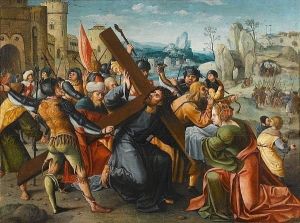Cornelius Engelbrechtsz Paintings
Cornelius Engelbrechtsz. was a Dutch painter born in Leiden in 1468, a city in the Netherlands which was to become a significant center for the arts in the 16th century. Engelbrechtsz. is considered among the earliest significant painters from Leiden and is often recognized as the head of the first Leiden school of painting. Not much is known about his early life and training; however, it is believed that he might have been influenced by the works of artists from the nearby city of Haarlem and possibly by those associated with the school of Rogier van der Weyden.
Engelbrechtsz.’s work was primarily religious in nature, reflecting the dominant themes of the late Middle Ages, but he also incorporated elements that foreshadowed the Northern Renaissance. His style is characterized by a subtle use of color and an attention to detail. He is especially noted for his expressive and emotional representations of religious scenes, a departure from the more stoic and static compositions of earlier periods. The faces in his paintings often convey a sense of individuality and personal emotion, which was a relatively new development in the art of his time.
Around 1497, Engelbrechtsz. established a workshop in Leiden, which became a training ground for several important Dutch painters. Among his pupils were Lucas van Leyden, who was to become one of the foremost artists of the Northern Renaissance, and Aertgen van Leyden, another notable painter of the era. Engelbrechtsz.’s influence on these artists was significant, and through them, his impact on the course of Dutch painting was considerable.
Engelbrechtsz. served as an alderman in Leiden and was involved in the local painters' guild. His role in the city was not limited to his artistic endeavors, as he was also active in civic matters. Engelbrechtsz. died in Leiden in 1533, leaving behind a body of work that is often seen as a bridge between the Gothic traditions of the late medieval period and the emerging Renaissance style that would come to define Dutch art in the 16th century. His works are today held in various museums and collections, offering insights into the transitional period of art in the Low Countries.


